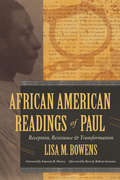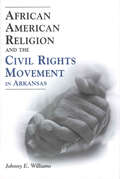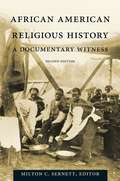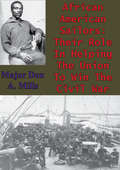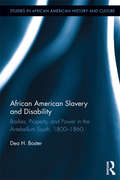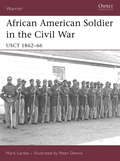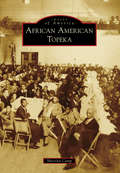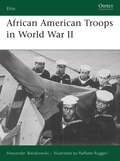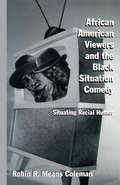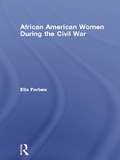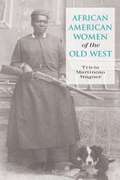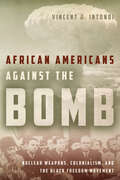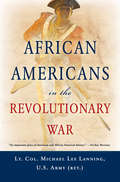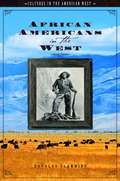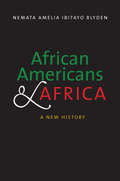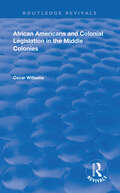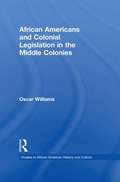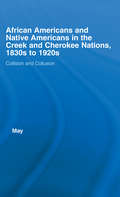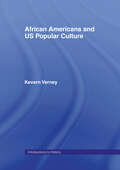- Table View
- List View
African American Readings of Paul: Reception, Resistance, and Transformation
by Lisa M. BowensThe letters of Paul—especially the verse in Ephesians directing slaves to obey their masters—played an enormous role in promoting slavery and justifying it as a Christian practice. Yet despite this reality African Americans throughout history still utilized Paul extensively in their own work to protest and resist oppression, responding to his theology and teachings in numerous—often starkly divergent and liberative—ways. In the first book of its kind, Lisa Bowens takes a historical, theological, and biblical approach to explore interpretations of Paul within African American communities over the past few centuries. She surveys a wealth of primary sources from the early 1700s to the mid-twentieth century, including sermons, conversion stories, slave petitions, and autobiographies of ex-slaves, many of which introduce readers to previously unknown names in the history of New Testament interpretation. Along with their hermeneutical value, these texts also provide fresh documentation of Black religious life through wide swaths of American history. African American Readings of Paul promises to change the landscape of Pauline studies and fill an important gap in the rising field of reception history.
African American Readings of Paul: Reception, Resistance, and Transformation
by Lisa M. BowensThe letters of Paul—especially the verse in Ephesians directing slaves to obey their masters—played an enormous role in promoting slavery and justifying it as a Christian practice. Yet despite this reality African Americans throughout history still utilized Paul extensively in their own work to protest and resist oppression, responding to his theology and teachings in numerous—often starkly divergent and liberative—ways. In the first book of its kind, Lisa Bowens takes a historical, theological, and biblical approach to explore interpretations of Paul within African American communities over the past few centuries. She surveys a wealth of primary sources from the early 1700s to the mid-twentieth century, including sermons, conversion stories, slave petitions, and autobiographies of ex-slaves, many of which introduce readers to previously unknown names in the history of New Testament interpretation. Along with their hermeneutical value, these texts also provide fresh documentation of Black religious life through wide swaths of American history. African American Readings of Paul promises to change the landscape of Pauline studies and fill an important gap in the rising field of reception history.
African American Religion and the Civil Rights Movement in Arkansas (Margaret Walker Alexander Series in African American Studies)
by Johnny E. WilliamsWhat role did religion play in sparking the call for civil rights? Was the African American church a motivating force or a calming eddy? The conventional view among scholars of the period is that religion as a source for social activism was marginal, conservative, or pacifying. Not so, argues Johnny E. Williams. Focusing on the state of Arkansas as typical in the role of ecclesiastical activism, his book argues that black religion from the period of slavery through the era of segregation provided theological resources that motivated and sustained preachers and parishioners battling racial oppression. Drawing on interviews, speeches, case studies, literature, sociological surveys, and other sources, Williams persuasively defines the most ardent of civil rights activists in the state as products of church culture. Both religious beliefs and the African American church itself were essential in motivating blacks to act individually and collectively to confront their oppressors in Arkansas and throughout the South. Williams explains how the ideology of the black church roused disparate individuals into a community and how the church established a base for many diverse participants in the civil rights movement. He shows how church life and ecumenical education helped to sustain the protest of people with few resources and little permanent power. Williams argues that the church helped galvanize political action by bringing people together and creating social bonds even when societal conditions made action difficult and often dangerous. The church supplied its members with meanings, beliefs, relationships, and practices that served as resources to create a religious protest message of hope.
African American Religions, 1500–2000
by Sylvester A. JohnsonThis book provides a narrative historical, postcolonial account of African American religions. It examines the intersection of Black religion and colonialism over several centuries to explain the relationship between empire and democratic freedom. Rather than treating freedom and its others (colonialism, slavery and racism) as opposites, Sylvester A. Johnson interprets multiple periods of Black religious history to discern how Atlantic empires (particularly that of the United States) simultaneously enabled the emergence of particular forms of religious experience and freedom movements as well as disturbing patterns of violent domination. Johnson explains theories of matter and spirit that shaped early indigenous religious movements in Africa, Black political religion responding to the American racial state, the creation of Liberia, and FBI repression of Black religious movements in the twentieth century. By combining historical methods with theoretical analysis, Johnson explains the seeming contradictions that have shaped Black religions in the modern era.
African American Religious History: A Documentary Witness
by Milton C. SernettThis widely-heralded collection of remarkable documents offers a view of African American religious history from Africa and early America through Reconstruction to the rise of black nationalism, civil rights, and black theology of today. The documents--many of them rare, out-of-print, or difficult to find--include personal narratives, sermons, letters, protest pamphlets, early denominational histories, journalistic accounts, and theological statements. In this volume Olaudah Equiano describes Ibo religion. Lemuel Haynes gives a black Puritan's farewell. Nat Turner confesses. Jarena Lee becomes a female preacher among the African Methodists. Frederick Douglass discusses Christianity and slavery. Isaac Lane preaches among the freedmen. Nannie Helen Burroughs reports on the work of Baptist women. African Methodist bishops deliberate on the Great Migration. Bishop C. H. Mason tells of the Pentecostal experience. Mahalia Jackson recalls the glory of singing at the 1963 March on Washington. Martin Luther King, Jr. writes from the Birmingham jail. Originally published in 1985, this expanded second edition includes new sources on women, African missions, and the Great Migration. Milton C. Sernett provides a general introduction as well as historical context and comment for each document.
African American Religious Studies: An Interdisciplinary Anthology
by Gayraud WilmoreThis anthology provides a coherent, interdisciplinary theoretical base for students of African American religious studies and will assist in the design of programs and courses for lay theological education and training. To this end, the editor has assembled material from Old and New Testament studies, theology, church history, pastoral counseling, worship, and social action.
African American Sailors: Their Role In Helping The Union To Win The Civil War
by Major Don A. Mills Sr. USMCSince the very beginning of American history, African Americans have served alongside their white counterparts in virtually every major armed conflict on the high seas. This was especially true during the Civil War. The Union Navy continued to experience a shortage of available manpower to sufficiently man its fleet of 600 plus ships. Life aboard naval vessels was particularly harsh and naval recruiters did not hesitate to enlist African Americans, free and slave, to ensure sufficient manning.African American sailors saw their service as an opportunity to rise above the status of social discrimination and segregation. Because of the shortage of able-bodied seamen in the Union Navy, African Americans were encouraged to join the naval service at a time when the Army and Marine Corps excluded their service. In an effort to attract African American recruits and to have them reenlist when their terms expired, the Navy tended to treat African American sailors with some degree of equality and respect once at sea. African American sailors were messed and quartered alongside their white counterparts. Per the leadership of the ship's captain, segregation and discrimination were regulated or was less prevalent than in 19th century America.The accomplishments of the Union Navy had a significant impact on its winning the war. The Union Navy could not have achieved its mission without nearly one-fifth of its total manpower, the African American sailor. Their numbers provided the credible force required to execute the strategic aims of the Anaconda Plan and helped to ensure a Union victory. The service of African American sailors allowed the North to end the war much sooner than it would have without their service, thus preventing an even greater number of loss to human life.
African American Slavery and Disability: Bodies, Property and Power in the Antebellum South, 1800-1860 (Studies in African American History and Culture #39)
by Dea H. BosterDisability is often mentioned in discussions of slave health, mistreatment and abuse, but constructs of how "able" and "disabled" bodies influenced the institution of slavery has gone largely overlooked. This volume uncovers a history of disability in African American slavery from the primary record, analyzing how concepts of race, disability, and power converged in the United States in the first half of the nineteenth century. Slaves with physical and mental impairments often faced unique limitations and conditions in their diagnosis, treatment, and evaluation as property. Slaves with disabilities proved a significant challenge to white authority figures, torn between the desire to categorize them as different or defective and the practical need to incorporate their "disorderly" bodies into daily life. Being physically "unfit" could sometimes allow slaves to escape the limitations of bondage and oppression, and establish a measure of self-control. Furthermore, ideas about and reactions to disability—appearing as social construction, legal definition, medical phenomenon, metaphor, or masquerade—highlighted deep struggles over bodies in bondage in antebellum America.
African American Soldier in the Civil War
by Peter Dennis Mark LardasApproximately 200,000 African Americans fought for the Union during the Civil War. Initially, many white soldiers doubted their bravery and skill; they were soon proved wrong. The United States Colored Troops performed countless acts of courage, most famously at the battle of Fort Wagner where the 54th Massachusetts marched forth and scaled the parapets, only to be driven back in fierce hand-to-hand combat. Through fascinating first-hand accounts, this title examines the journey of the African American from slave to soldier to free man, ultimately providing a fascinating insight into the impact that these brave men had on the war and how it influenced their lives thereafter.
African American St. Louis: Disappearing Black Communities (Images of Modern America)
by John A. Wright Sr. Curtis A. Wright Sr. John A. Wright Jr.The city of St. Louis is known for its African American citizens and their many contributions to the culture within its borders, the country, and the world. Images of Modern America: African American St. Louis profiles some of the events that helped shape St. Louis from the 1960s to the present. Tracing key milestones in the city's history, this book attempts to pay homage to those African Americans who sacrificed to advance fair socioeconomic conditions for all. In the closing decades of the Great Migration north, the civil rights movement was taking place nationally; simultaneously, St. Louis's African Americans were organizing to exert political power for greater control over their destiny. Protests, voter registration, and elections to public office opened new doors to the city's African Americans. It resulted in the movement for fairness in hiring practices and the expansion of the African American presence in sports, education, and entertainment.
African American Studies Kennedy-King College
by Editors at the PearsonThis book on African American studies covers topics like : Black People in Colonial North America,The Meaning of Freedom: The Promise of Reconstruction,The Failure of Reconstruction,White Supremacy Triumphant,Black Nationalism, Black Power, Black Arts etc.
African American Topeka (Images of America)
by Sherrita CampAfrican Americans arrived in Topeka right before and after the Civil War and again in large numbers during the Exodus Movement of 1879 and Great Migration of 1910. They came in protest of the treatment they received in the South. The history of dissent lived on in Topeka, as it became the home to court cases protesting discrimination of all kinds. African Americans came to the city determined that education would provide them a better life. Black educators fostered a sense of duty toward schooling, and in 1954 Topeka became a landmark for African Americans across the country with the Brown vs. Topeka Board of Education case. Blacks from every walk of life found refuge in Kansas and, especially, Topeka. The images in African American Topeka have been selected to give the reader a glimpse into the heritage of black life in the community. The richness of the culture and values of this Midwestern city are a little-known secret just waiting to be exhibited.
African American Troops in World War II
by Raffaele Ruggeri Alexander BielakowskiOsprey's study of the African Americans' involvement in World War II (1939-1945). Despite the contribution of black units to the American Expeditionary Force in World War I (1914-1918), and the commissioning of hundreds of black officers to lead them, the small interwar US Army continued to regard them as unsuited to both leadership roles and handling modern technology. Although African Americans had to strive against prejudice for every chance to show what they could achieve, in fact the wartime US Army conceded opportunities for leadership unparaleled in American civil society at that date. In World War II tens of thousands served in segregated units. While the majority were denied the opportunity of combat, a minority of all-black, black-officered units proved their worth in all theaters and a number of roles: black officer fighter pilots (the "Tuskegee Airmen") blazed the trail, followed by several tank and tank-destroyer battalions and a few field artillery units; and more than 20,000 black infantrymen served under both white and black officers. The Army also created the first fully integrated units, whose success prompted President Truman to order the complete integration of the military in 1948. The US Navy and Marines were slower to allow blacks to serve in combat roles and to commission black officers, but by 1945 two complete ships' companies were composed of African-Americans (though with white officers).
African American Viewers and the Black Situation Comedy: Situating Racial Humor (Studies in African American History and Culture)
by Robin R. Means ColemanProviding new insight into key debates over race and representation in the media, this ethnographic study explores the ways in which African Americans have been depicted in Black situation comedies-from 1950's Beulah to contemporary series like Martin and Living Single.
African American Voices: The Life Cycle of Slavery
by Steven Mintz<p>The 58 selections in this volume cover the history of slavery in America, moving from memories of growing up in Africa to the trials of the Middle Passage, the horrors of the auction block, the sustaining forces of family and religions, acts of resistance, and the meaning of the Civil War and emancipation, presenting 300 years in the collective life cycle of an enslaved people. <p>Mintz's extensive introduction is followed by substantial excerpts from published slave narratives, interviews with former slaves, and letters written by enslaved African Americans. The end of the volume includes a bibliographic essay and a 40-page bibliography, making this an indispensible book for the study of slavery.</p>
African American Women During the Civil War (Studies in African American History and Culture)
by Ella ForbesThis study uses an abundance of primary sources to restore African American female participants in the Civil War to history by documenting their presence, contributions and experience. Free and enslaved African American women took part in this process in a variety of ways, including black female charity and benevolence. These women were spies, soldiers, scouts, nurses, cooks, seamstresses, laundresses, recruiters, relief workers, organizers, teachers, activists and survivors. They carried the honor of the race on their shoulders, insisting on their right to be treated as "ladies" and knowing that their conduct was a direct reflection on the African American community as a whole.For too long, black women have been rendered invisible in traditional Civil War history and marginal in African American chronicles. This book addresses this lack by reclaiming and resurrecting the role of African American females, individually and collectively, during the Civil War. It brings their contributions, in the words of a Civil War participant, Susie King Taylor, "in history before the people."
African American Women of the Old West
by Tricia Martineau WagnerThe brave pioneers who made a life on the frontier were not only male; and they were not only white. The story of African-American women in the Old West is one that has largely gone untold--until now. The story of ten African-American women is reconstructed from historic documents found in century-old archives. The ten remarkable women in Black Women of the Old West were all born before 1900, some were slaves, some were free, and some lived both ways during their lifetime. Among them were laundresses, freedom advocates, journalists, educators, midwives, business proprietors, religious converts, philanthropists, mail and freight haulers, and civil and social activists.
African Americans Against the Bomb: Nuclear Weapons, Colonialism, and the Black Freedom Movement
by Vincent J. IntondiWell before Rev. Dr. Martin Luther King, Jr. spoke out against nuclear weapons, African Americans were protesting the Bomb. Historians have generally ignored African Americans when studying the anti-nuclear movement, yet they were some of the first citizens to protest Truman's decision to drop atomic bombs in Hiroshima and Nagasaki in 1945. Now for the first time, African Americans Against the Bomb tells the compelling story of those black activists who fought for nuclear disarmament by connecting the nuclear issue with the fight for racial equality. Intondi shows that from early on, blacks in America saw the use of atomic bombs as a racial issue, asking why such enormous resources were being spent building nuclear arms instead of being used to improve impoverished communities. Black activists' fears that race played a role in the decision to deploy atomic bombs only increased when the U.S. threatened to use nuclear weapons in Korea in the 1950s and Vietnam a decade later. For black leftists in Popular Front groups, the nuclear issue was connected to colonialism: the U.S. obtained uranium from the Belgian controlled Congo and the French tested their nuclear weapons in the Sahara. By expanding traditional research in the history of the nuclear disarmament movement to look at black liberals, clergy, artists, musicians, and civil rights leaders, Intondi reveals the links between the black freedom movement in America and issues of global peace. From Langston Hughes through Lorraine Hansberry to President Obama, African Americans Against the Bomb offers an eye-opening account of the continuous involvement of African Americans who recognized that the rise of nuclear weapons was a threat to the civil rights of all people.
African Americans In The Revolutionary War
by Lt. Col. Lanning&“A thorough, long-overdue study of Black Americans&’ contributions during the War of Independence. . . . An important piece of American and African American history.&”—Kirkus Reviews In this enlightening and informative work, military historian Lt. Col. Michael Lee Lanning (ret.) reveals the little-known, critical, and heroic role African Americans played in the American Revolution, serving in integrated units—a situation that would not exist again until the Korean War—more than 150 years later . . . At first, neither George Washington nor the Continental Congress approved of enlisting African Americans in the new army. Nevertheless, Black men—both slave and free—filled the ranks and served in all of the early battles. Black sailors also saw action in every major naval battle of the Revolution, including members of John Paul Jones&’s crew aboard the Bonhomme Richard. At least thirteen Black Americans served in the newly formed U.S. Marine Corps during the war. Bravery among African Americans was commonplace, as recognized by their commanders and state governments, and their bravery is recorded here in the stories of citizen Crispus Attucks at the Boston Massacre; militiaman Price Esterbrook at Lexington Green; soldier Salem Poor at Bunker Hill; and marine John Martin aboard the brig Reprisal. As interest in colonial history enjoys renewed popularity due to works like Hamilton, and the issues of prejudice and discrimination remain at the forefront of our times, African Americans in the Revolutionary War offers an invaluable perspective on a crucial topic that touches the lives of Americans of every color and background.
African Americans In The West
by Douglas FlammingThe story of the African American experience in the Western US, from colonial times to the present, is chronicled in this accessible reference for students in high school and up. The book begins by examining slavery on the moving frontier, and the ways in which the frontier ultimately resulted in the abolition of slavery in America. It continues by examining African American life in the western region as a whole, with material on black cowboys, the rise of the NAACP, the Tulsa race riot, race and organized labor, the era of Black Nationalism, and blacks in Hollywood. The chapter on the African American West since 1980 examines topics including the Rodney King beating, gangsta rap, and suburbanization. The final chapter examines the historiography of the Black West and current issues in multiracial history. A chronology and a glossary are included. Flamming teaches history at the Georgia Institute of Technology.
African Americans and Africa: A New History
by Nemata Amelia BlydenAn introduction to the complex relationship between African Americans and the African continent What is an “African American” and how does this identity relate to the African continent? Rising immigration levels, globalization, and the United States’ first African American president have all sparked new dialogue around the question. This book provides an introduction to the relationship between African Americans and Africa from the era of slavery to the present, mapping several overlapping diasporas. The diversity of African American identities through relationships with region, ethnicity, slavery, and immigration are all examined to investigate questions fundamental to the study of African American history and culture.
African Americans and Colonial Legislation in the Middle Colonies (Studies In African American History And Culture Ser.)
by Oscar WilliamsFirst published in 1998. During the first quarter of the seventeenth century Blacks began arriving in the middle colonies region. At first, regulation of these individuals posed no problem, but by the beginning of the eighteenth century it became increasingly obvious that specific laws governing Blacks needed to be legislated in detail. New York took the lead by having more slaves and legislation than New Jersey and Pennsylvania. This study is primarily an effort to analyze and compare legislation governing Blacks in the middle colonies.
African Americans and Colonial Legislation in the Middle Colonies (Studies in African American History and Culture)
by Oscar WilliamsThis study analyzes legislation governing black life in New York, New Jersey, and Pennsylvania. The years from 1664 to 1712 witnessed the formative era of slavery in the middle colonies, and by the beginning of the 18th century, specific laws governing African Americans were passed. The long range effects of the Insurrection of 1712 (which took the lives of nine whites and critically wounded five others) and the Negro Conspiracy of 1741 produced extensive slave codes in New York and New Jersey. Pennsylvania took the more subtle approach of high tariffs, starting a tariff war against slavery.Free blacks suffered under the harsh slave codes, as laws which restricted the movement of slaves also restricted the movement of free African Americans. Slaves were considered property protected by law, but free blacks were denied even this minor protection. Fear of insurrection led New York City, Albany, and Philadelphia to pass restrictive legislation. The greatest obstacle to freeing slaves was legislation requiring manumission bonds. As a result of a diversified economy, African Americans performed virtually every type of labor in the frontier communities of the middle colonies, and developed more skills than their southern counterparts. Eventually, the influx of whites provided cheap day labor that reduced dependency upon slave labor.(Ph.D. dissertation, Ohio State University, 1969; revised with new preface and foreword)
African Americans and Native Americans in the Cherokee and Creek Nations, 1830s-1920s: Collision and Collusion (Studies in African American History and Culture)
by Katja MayFirst published in 1996. Routledge is an imprint of Taylor & Francis, an informa company.
African Americans and US Popular Culture
by Kevern VerneyThis volume is an authoritative introduction to the history of African Americans in US popular culture, examining its development from the early nineteenth century to the present. Kevern Verney examines: * the role and significance of race in all major forms of popular culture, including sport, film, television, radio and music* how the entertainment industry has encouraged racism through misrepresentations and caricatured images of African Americans. African Americans have made a unique contribution to the richness and diversity of US popular culture. Rooted in African society and traditions, black slaves in America created a dynamic culture which continues to evolve. Present day hip-hop and rap music are still shaped by the historical experience of slavery and the ongoing will to oppose oppression and racism. Any student of African-American history or cultural studies will find this a fascinating and highly useful book.
